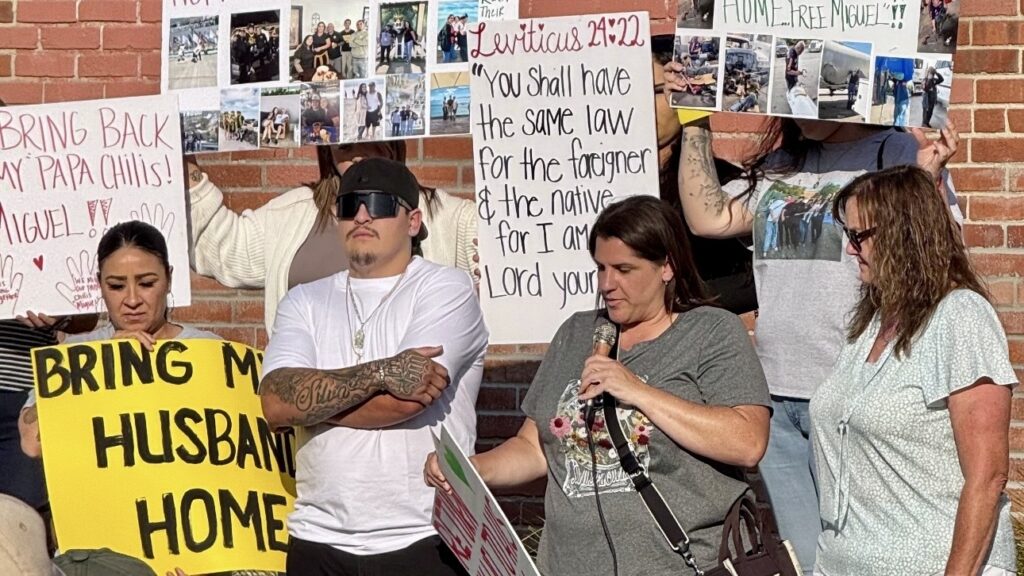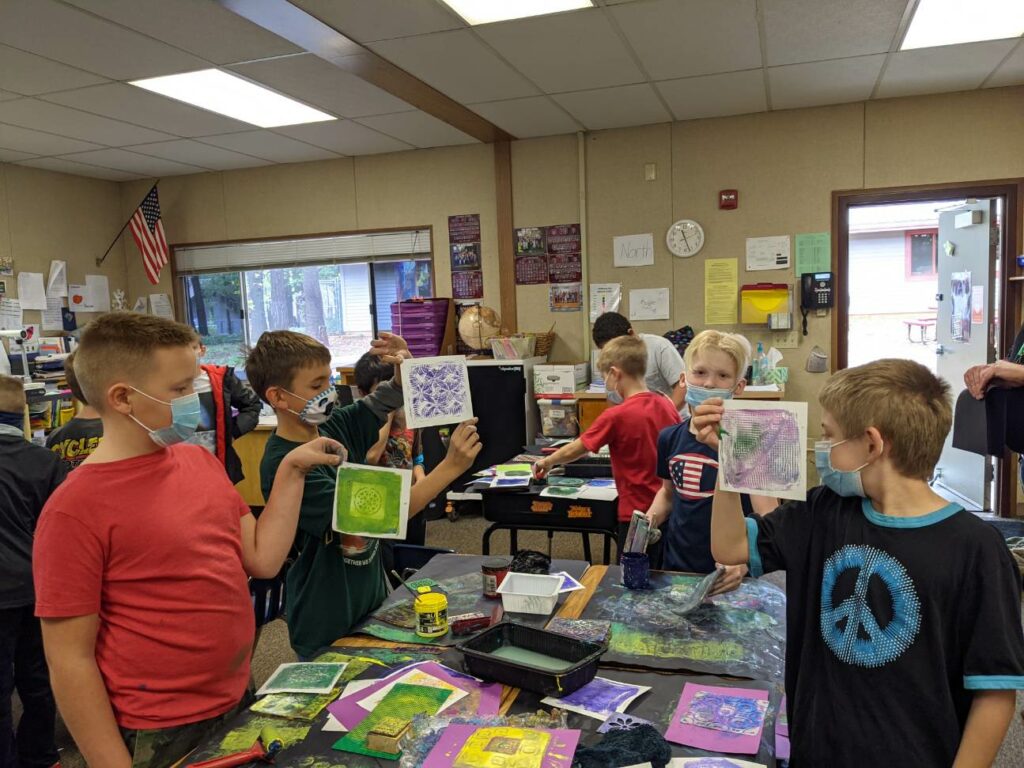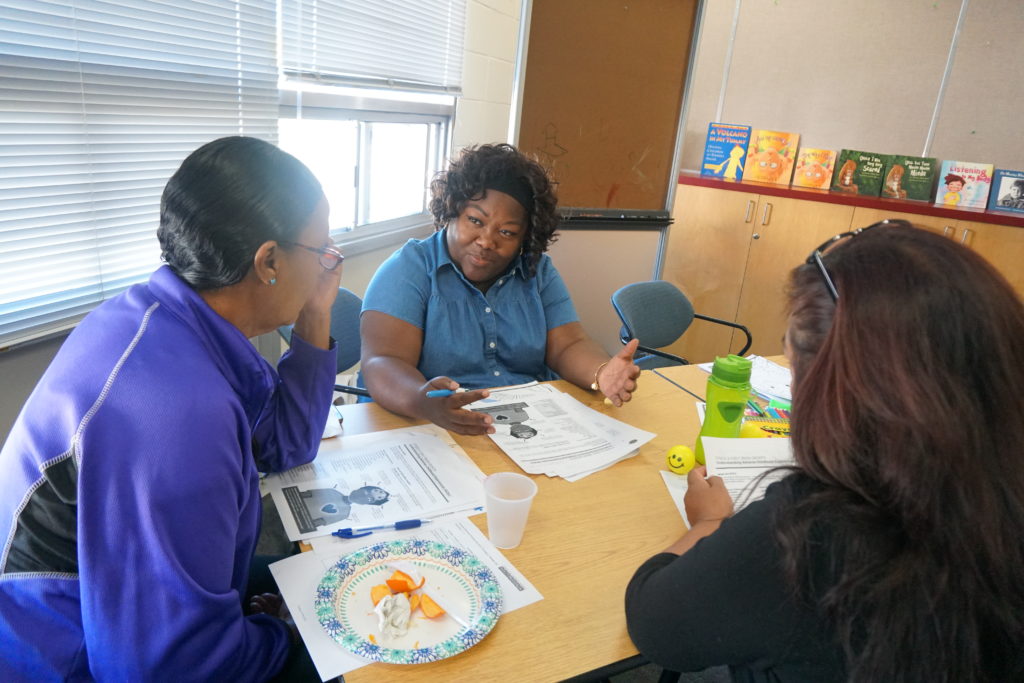
Teacher Laura Brown, second from right, speaks at a rally for Miguel Angel Lopez, alongside teacher Betsy Wilson, Lopez’s wife Rosa Lopez, and son-in-law Jimmy Silva.
Courtesy of Becca Esquivel Makris
Top Takeaways
- Some schools across California report that parents — and sometimes students — have been detained by immigration officials.
- Teachers and other school staff are stepping up to help families get the resources they need.
- When a parent is detained or deported, students may become eligible for homeless services.
The day before final exams started at Granada High School in Livermore, special education teacher Laura Brown got word that a student’s father had been detained by immigration officers.
Brown didn’t hesitate. She immediately called the student’s mother, Rosa Lopez, and went over to her house that night. She had known the family for 12 years, ever since the oldest son had been her student. The youngest, who just finished his sophomore year in high school, stops by her classroom regularly just to say hi.
Together, Brown and Lopez wrote a message calling for help. Within hours, they had contacted their local congressional representative, mayor and local activists. Another teacher, Betsy Wilson, helped organize a rally to protest Miguel Angel Lopez’s detention. Days later, he was deported to Tijuana. As his wife travels to Mexico to help him, Brown and Wilson are still trying to support the family.
“That’s the call of a teacher,” Brown said. “Your students need you and that’s it.”
She would do the same for any student, she said.
“Right now, if a student has anyone in their family that has an unknown legal status, it would be really hard for us to expect that their brains are going to be capable of learning and taking in content when they’re in such a traumatized and fearful state,” Brown said.
SUPPORTING IMMIGRANT FAMILIES
As U.S. Immigration and Customs Enforcement raids ramp up across California, so have reports of students grappling with trauma, upheaval and fear after family members — and sometimes students themselves — are detained.
A fourth grader in Torrance and his father were sent to a detention center in Texas after an appointment with federal immigration officials on May 29. They were later deported to Honduras.
In San Francisco, at least 15 people, including four children, were detained by ICE at scheduled immigration check-ins on June 4, according to advocates. In May, a first grader in the district was deported with his mom to Nicaragua after attending an immigration appointment as part of their application for a visa.
“There was no chance for them to return home to get any of their belongings or to say goodbye,” said Maggie Furey, a social worker in the district. “The first grader left school Friday not knowing that they were never going to see their friends, teacher or community again.”
Furey said the child’s deportation hit his classmates and teachers hard.
“A lot of the adults were extremely distraught, and we saw heightened anxiety in our community because we have other families that have immigration appointments coming up and were really fearful,” Furey said. “The kids really missed the student, and you’re having to have really big conversations on a first-grade level with kids.”
She said the child’s teacher set up an international video call so his classmates could say goodbye.
We’ve had to call upon our therapists, our social workers at our school site to be able to have those heart-to-heart conversations with their students when they’re feeling anxious, stressed or very worried
Efrain Tovar
In Los Angeles, dozens of people have been detained by ICE in recent days, and raids on businesses near schools have sparked fears that immigration agents may target graduation ceremonies. A Los Angeles Unified School District high school sophomore was detained last week, alongside her mother and sibling. She has since been sent to a detention center in Texas.
The effects on students extend beyond the communities where the most publicized raids have occurred. Efrain Tovar, who teaches English language development to English learners and immigrant students at Abraham Lincoln Middle School in Selma, in the Central Valley, said he’s seen an increase in fear and uncertainty.
“We’ve had to call upon our therapists, our social workers at our school site to be able to have those heart-to-heart conversations with their students when they’re feeling anxious, stressed or very worried,” said Tovar. “It’s a reality that our students are facing, and students cannot learn when these types of events flare up in the classroom.”
He said, in addition, many immigrant students are unsure of where they will be next school year, which makes it hard for them to plan for high school or the future.
“There’s this feeling among the newcomers that ‘we don’t know if we’ll be back next year.’ As we end the school year, there’s a lot of what-ifs,” Tovar said.
Jesús Vedoya Rentería, who teaches English at Hanford West High School in the Central Valley, said in response to the fear among their peers, some of his students have decided to pass out “know-your-rights” cards outside Mexican markets or at the swap meet on weekends. He said it makes them feel more empowered.
“They were concerned a lot of raids were going on and said we owed it to our immigrant population to make sure they’re informed,” Vedoya Rentería said.
School staff are anxious to know what they can do to help students and families, said Ana Mendoza, director of education equity and senior staff attorney at ACLU of Southern California. She said the organization has worked with several school districts to provide presentations on students’ and families’ rights regarding immigration enforcement and training for school employees.
“Schools have the obligation to ensure families know that students have the right to attend California public schools,” Mendoza said.
Federal law gives all children the right to a free public education, regardless of immigration status. Under California law, school districts must notify parents and guardians of that right. The state attorney general recommends that schools also work with parents to create a plan for who should have custody of the child if parents are detained, and that school staff connect families with legal help or other resources.
A family separated
When Granada High School teachers stepped up to help Rosa Lopez, the mother in Livermore, it meant a lot, she said.
“If it wasn’t for them, I would [have] probably be[en] home with my arms crossed just waiting for Miguel or the lawyer to call,” said Lopez. “That really motivated me and hyped me up, because I was like, ‘OK, I got this and I know I can do this, and we’re going to bring Miguel home.’”
Lopez said her husband’s detention and deportation have deeply affected her kids, who are 24, 23 and 17 years old.
“We’ve never been apart from each other,” she said. “He is the one always making sure we’re OK.”

Her youngest son, Julian, had to take final exams the day after his dad’s detention, but it helped that his teachers knew what he was going through, she said.
“My oldest son, he doesn’t know how to express his emotion, but I can see the sadness in his face, and he said he feels like the house isn’t home because his dad’s not here,” she said.
The couple’s granddaughter, who is 3 years old, doesn’t understand why her grandfather isn’t home. “She grabs his picture and says, ‘I want to go with Papa,’” her name for her grandpa, Lopez said.
Lopez, who is a U.S. citizen, said she applied for her husband to become a permanent legal resident after getting married in 2001, but the government initially denied the application, and the couple has been battling that decision in court for years. She said her husband was originally taken to a detention center in McFarland, but early Saturday morning, he called her from Tijuana and told her he was left there by immigration authorities without his Mexican passport or his California driver’s license.
“I lost it when he told me,” Lopez said. “This wasn’t the way it was supposed to go.”
She immediately booked a flight to Mexico to bring her husband clothes and his birth certificate and help him complete paperwork to get a new Mexican passport. She plans to continue to fight the deportation in court.
Students may be eligible for McKinney-Vento resources
Mendoza, from the ACLU, said after a family member is detained, school staff should check if a student’s housing situation has changed, which could then make them eligible for services for homeless students, under the federal law known as the McKinney-Vento Homeless Assistance Act.
If a student’s parent or guardian is detained, they may have to live with a new family member, for example, or the loss of income of one parent may require a student’s family to move to a new home. In that case, students have the right to stay in the same school even if they have moved farther away, and they may need help with transportation to get to school, Mendoza said.
“Stability is really important,” said Mendoza. “But if they [school staff] don’t inquire about why an address has changed, they might miss that it’s a housing instability that would then trigger McKinney-Vento.”
School personnel at a school district in Ontario, outside of Los Angeles, said they were recently approached by a grandmother who was caring for her grandchildren and needed food and clothing for them. Only after inquiring about their living situation did the district learn that the children’s parents had been detained by ICE. Their particular situation qualified them for homeless assistance resources.
“I think there’s this hesitancy to talk about ‘what does this mean for our immigrant students?’ But I think it’s even more important now because we never know who students will feel comfortable sharing that information with,” said Karen Rice, a senior program manager at student-advocacy organization SchoolHouse Connection.
So many of our members want to know, what do I do in the event that ICE does get past the office and into the classrooms?
Yajaira Cuapio
At Coachella Valley Unified School District, an uptick in fear of immigration enforcement is contributing to homelessness among families. Karina Vega, a district support counselor, said immigration-related changes in students’ lives vary widely. Some parents have had to temporarily leave the country as part of the residency process; others have a deported parent, leaving the remaining parent struggling to make ends meet on their own; others are constantly moving to stay off the radar of immigration officials.
The information from the state attorney general about how to help immigrant students and families is not always getting to teachers, said Yajaira Cuapio, a social worker with the San Francisco Unified School District. She said the teachers union, United Educators of San Francisco, is asking the district to include training on sanctuary policies in the teachers’ contract.
“So many of our members want to know, what do I do in the event that ICE does get past the office and into the classrooms?” Cuapio said. “What are our rights? What do I do as an educator?”







